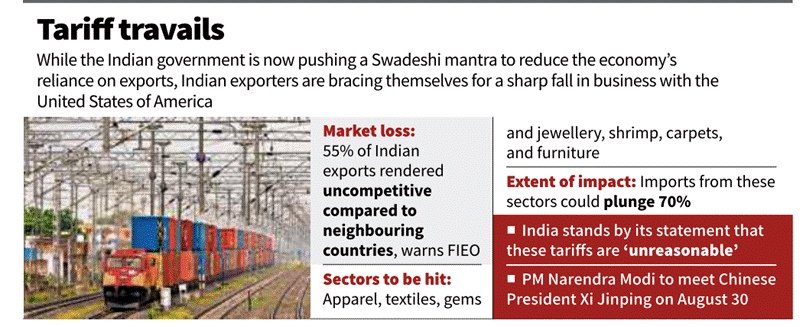Trade Relationship
- India–US trade (2024–25):
- Goods trade: ~$200 bn (US is India’s largest trading partner).
- Services trade: ~$65–70 bn (IT, consulting, digital services major contributors).
- India exports to US: ~2% of India’s GDP; exposure to tariffs (after exemptions) ≈ 12% of GDP exports.
- New tariffs (Aug 27, 2025):
- US imposed 50% tariffs on Indian goods (some exemptions → pharma, consumer electronics).
- Immediate effect limited, but secondary + tertiary effects (supply chains, investor sentiment, FDI flows) more worrying.
Relevance : GS 2(international Relations), GS 3(Indian Economy)

Diplomatic Context
- US Treasury Secretary Bessent:
- Called India–US relationship “complicated”.
- Stressed that Trump & Modi enjoy strong personal rapport.
- Assured that “end of the day, both countries will come together”.
- Donald Trump’s stance:
- Reiterated claims of brokering India–Pakistan ceasefire (May 2025), even suggesting he “prevented a nuclear conflict”.
- Threatened India with “tariffs so high your head will spin” if hostilities resumed.
- Highlights Trump’s transactional style → linking security issues (India–Pakistan) with trade deals.
- Indian Govt response:
- Commerce Ministry: “Communication lines open” with US; also engaging industry to soften tariff impact.
- Ongoing India–US FTA talks, but progress slow due to divergences (agriculture, digital trade, tariffs).
Geopolitical Layer
- India–Pakistan angle:
- Trump claims → pressure diplomacy (“stop war or face tariffs”).
- India rejects external mediation, but acknowledges US influence in crisis de-escalation.
- Energy & Russia factor:
- US pushing India on Russian oil imports.
- India balancing → cheap Russian crude vs. avoiding sanctions.
- Visas & People-to-People ties:
- Parallel US debates: H-1B visas (DeSantis calling them a “scam”), green card reforms.
- Impacts ~1 million Indian professionals in US → politically sensitive.
Domestic Implications for India
- Economic:
- Immediate tariff impact small (0.1% GDP hit).
- Risk of export diversification pressure → India needs FTAs with EU, UK, others.
- MSMEs & textile/handicraft exporters most affected.
- Political:
- Modi–Trump personal rapport may cushion fallout.
- But Trump’s rhetoric (“your head will spin”) plays into domestic political optics.
- Strategic:
- India cannot allow trade tensions to spill over into defense cooperation (Quad, Indo-Pacific strategy, defense tech transfers).
Opportunities for India
- Negotiating leverage: India can offer tariff reductions on US agri/energy imports in exchange for easing tariffs.
- Diversification: Boosting trade with EU, UK (FTAs signed), ASEAN, Africa to reduce overdependence on US.
- Reforms push: Tariff shock can accelerate domestic reforms (logistics, ease of doing business, MSME digitization).
Risks & Challenges
- Transactional Trump: Uses tariffs as foreign policy tool → creates uncertainty.
- Domestic US politics: H-1B crackdown, election year rhetoric can harden stance on India.
- Geopolitical linkage: US tying India–Pakistan conflict to trade concessions complicates India’s diplomatic space.
- Investor sentiment: Long-term US tariffs could discourage US FDI in Indian manufacturing.
Big Picture
- India–US ties = multi-dimensional (trade, defense, people-to-people, Indo-Pacific security).
- Current tensions underline the need for:
- Redrawing India’s trade “red lines” (per Editorial note).
- Accelerating domestic reforms (infrastructure, MSMEs, e-commerce exports).
- Strategic hedging: Balancing US pressure with alternative markets (EU, ASEAN, BRICS).
Key Takeaways
- India–US trade conflict (2025) = economic + political + geopolitical mix.
- Tariff impact modest on GDP, but secondary effects → riskier (exports, FDI, supply chains).
- Trump’s rhetoric links security (India–Pak conflict) with trade concessions, complicating matters.
- India must use this pressure as an opportunity to diversify trade & accelerate reforms, while safeguarding strategic ties with the US.



